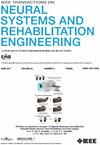SRRNet:用于 SSVEP-BCIs 中跨刺激传递的来自刺激的非可见 SSVEP 响应回归
IF 4.8
2区 医学
Q2 ENGINEERING, BIOMEDICAL
IEEE Transactions on Neural Systems and Rehabilitation Engineering
Pub Date : 2025-04-14
DOI:10.1109/TNSRE.2025.3560434
引用次数: 0
摘要
基于稳态视觉诱发电位(SSVEP)的脑机接口(bci)需要较长的校准时间,这对实际应用构成了重大挑战。交叉刺激转移是一种很有前途的解决方案,其中在类的子集(见类)上训练的模型可以预测见类和未见类。现有方法从已见类的SSVEP模板中提取公共组件,为未见类构造模板;然而,它们受到特定于类的活动和包含在这些组件中的噪声的限制,导致不精确的模板降低了分类性能。为了解决这一问题,本研究提出了一个SSVEP响应回归网络(SRRNet),该网络使用已见类数据学习正弦余弦参考信号与SSVEP模板之间的回归映射。该网络利用相应的正弦余弦信号重构了未见类的SSVEP模板。此外,引入了SSVEP模板回归和空间滤波(SRSF)框架,通过任务相关成分分析(TRCA)空间滤波器对测试数据和SSVEP模板进行投影,并计算相关性进行目标预测。在两个公共数据集上的对比评估表明,我们的方法明显优于最先进的方法,将信息传输速率(ITR)从173.33 bits/min提高到203.79 bits/min。通过有效地建模从正弦余弦参考信号到SSVEP模板的回归,SRRNet可以为未见过的类构建SSVEP模板,而无需从这些类中提取训练样本。通过将回归的SSVEP模板与基于空间滤波的方法相结合,增强了SSVEP- bci的交叉刺激传递性能,从而提高了SSVEP- bci的实用性。代码可在https://github.com/MaiXiming/SRRNet上获得。本文章由计算机程序翻译,如有差异,请以英文原文为准。
SRRNet: Unseen SSVEP Response Regression From Stimulus for Cross-Stimulus Transfer in SSVEP-BCIs
The prolonged calibration time required by steady-state visual evoked potential (SSVEP)-based brain-computer interfaces (BCIs) poses a significant challenge to real-life applications. Cross-stimulus transfer emerges as a promising solution, wherein a model trained on a subset of classes (seen classes) can predict both seen and unseen classes. Existing approaches extracted common components from SSVEP templates of seen classes to construct templates for unseen classes; however, they are limited by the class-specific activities and noise contained in these components, leading to imprecise templates that degrade classification performance. To address this issue, this study proposed an SSVEP Response Regression Network (SRRNet), which learned the regression mapping between sine-cosine reference signals and SSVEP templates using seen class data. This network reconstructed SSVEP templates for unseen classes utilizing their corresponding sine-cosine signals. Additionally, an SSVEP template regressing and spatial filtering (SRSF) framework was introduced, where both test data and SSVEP templates were projected by task-related component analysis (TRCA) spatial filters, and correlations were computed for target prediction. Comparative evaluations on two public datasets revealed that our method significantly outperformed state-of-the-art methods, elevating the information transfer rate (ITR) from 173.33 bits/min to 203.79 bits/min. By effectively modeling the regression from sine-cosine reference signals to SSVEP templates, SRRNet can construct SSVEP templates for unseen classes without training samples from those classes. By integrating regressed SSVEP templates with spatial filtering-based methods, our method enhances cross-stimulus transfer performance in SSVEP-BCIs, thus advancing their practical applicability. The code is available at https://github.com/MaiXiming/SRRNet .
求助全文
通过发布文献求助,成功后即可免费获取论文全文。
去求助
来源期刊
CiteScore
8.60
自引率
8.20%
发文量
479
审稿时长
6-12 weeks
期刊介绍:
Rehabilitative and neural aspects of biomedical engineering, including functional electrical stimulation, acoustic dynamics, human performance measurement and analysis, nerve stimulation, electromyography, motor control and stimulation; and hardware and software applications for rehabilitation engineering and assistive devices.

 求助内容:
求助内容: 应助结果提醒方式:
应助结果提醒方式:


